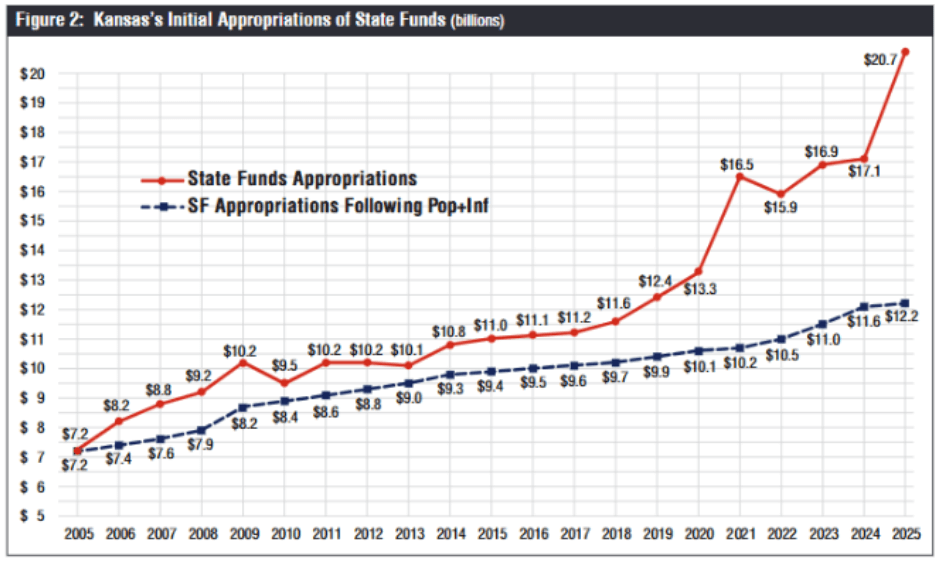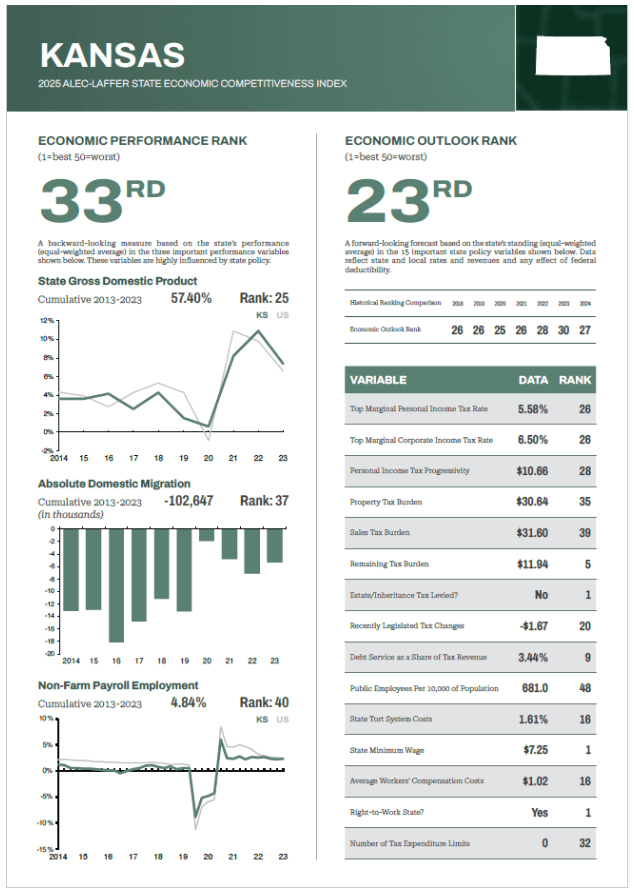Kansas is finally gaining ground in the race for economic competitiveness.
According to the newly released Rich States, Poor States 2025 report by the American Legislative Exchange Council (ALEC), Kansas improved its economic outlook ranking from 30th in 2023 to 27th in 2024—and now to 23rd in 2025. That’s the state’s best performance in years, showing how pro-growth reforms are starting to pay off. Notably, this jump comes even before the latest round of income tax relief–by overriding Gov. Kelly’s needless veto of further tax reductions just last week–takes effect.
The ALEC-Laffer rankings are based on 15 forward-looking policy variables that shape a state’s economic trajectory, including tax rates, labor policy, and fiscal stability. Kansas moved up the list mainly because of efforts to flatten income taxes, maintain right-to-work protections, and remove specific barriers to business investment. And unlike high-tax states stuck at the bottom, such as New York (50th) and California (48th), Kansas is showing that it’s ready to compete.
But improving rankings only tells part of the story.
A true economic transformation requires sustained fiscal discipline. The Responsible Kansas Budget, released by us at the Kansas Policy Institute, shows that the state still has a serious spending problem. In FY 2025, the Kansas budget was $8.5 billion higher than if the state funds budget had increased by just the rate of population growth plus inflation since 2005 and $56 billion higher cumulatively since then.

This is where Kansas policymakers must be vigilant. The state is headed in the right direction with its tax policy, but history could repeat itself unless spending is controlled. Just more than a decade ago, Kansas cut taxes without aligning expenditures, which resulted in fiscal strain and, ultimately, tax hikes that damaged the state’s economic competitiveness.
To avoid falling into the same trap, Kansas must adopt stronger state and local spending limits that ensure government grows no faster than the average Kansan’s ability to pay. The Responsible Kansas Budget offers a clear path forward by tying spending growth to population and inflation, protecting taxpayers while still funding essential services.
While Kansas’s economic outlook rank has steadily improved, its economic performance rank—which measures actual outcomes like GDP growth, employment, and domestic migration over the past decade—remains stuck at 33rd. This gap underscores the long-term damage from past missteps and the need to stay on course.
The good news? With thoughtful reforms, Kansas can climb even higher.
Recent legislation, including SB 269, provides a roadmap. This law sets up a mechanism for future tax rate reductions by using surplus revenue to gradually reduce income and corporate tax rates to as low as 4% for individuals and 2.6% for banks—but only if there’s sufficient growth and the budget stabilization fund hits 15% of general fund revenues. That’s a smart way to build in both discipline and opportunity.
Kansas Policy Institute continues to advocate for eliminating the state income tax altogether. States like Texas, Florida, and Tennessee thrive without income taxes, and Kansas can, too. But to ensure long-term success, Kansas must pair tax relief with spending restraint.
The Rich States, Poor States report is more than a ranking—it reflects policy choices. Kansas’s climb from 30th to 23rd in just two years shows what’s possible when lawmakers focus on pro-growth reforms. But to truly become a destination for entrepreneurs, families, and investment, Kansas must go further.
By reducing taxes, limiting spending, and staying committed to economic freedom, Kansas can become not just a state on the rise but a national model for allowing people to prosper.






